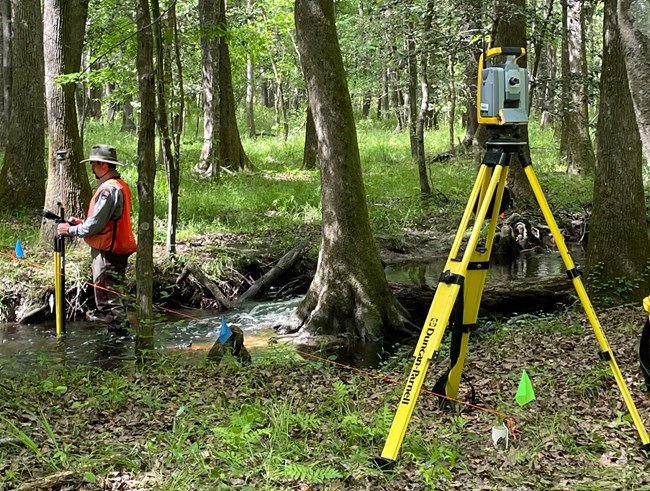
NPS photo
Wadeable streams and adjacent vegetation serve as habitats for a variety of local wildlife and plants. These small streams provide resources for native fish such as the blackbanded darter, and provide water and shelter for wildlife such as deer. Any negative change will result in losses for species that rely on these streams directly or indirectly for sustenance. Additionally, these streams were historically important to the development of commerce, manufacturing, and agriculture.
Wadeable streams allow visitors to enjoy the natural beauty of riverine resources by providing:
- Beautiful views
- Recreational fishing spots
- Cultural sites
- Quiet spaces to relax
- Areas to watch birds or other wildlife
The condition of the streams and the habitats they provide are critical for the health of the local ecosystems and visitor enjoyment. Streams are affected by human development such as dams, flooding, drought, and changes in sediment. The Southeast Coast Network will monitor wadeable streams to track changes in bank erosion, width and depth, sediment, and watershed land use. Providing this information to park resource managers helps maintain the health and beauty of stream resources.
Monitoring Objectives
There are three main objectives for monitoring wadeable stream habitats in Southeast Coast Network parks.
- Determine what is taking place upstream of the monitored site or stream reach.
- Determine the status of and trends in various geomorphic variables including width of the channel, bank heights, angles, and vegetative cover, along with the slope and sinuosity (streams ability to curve or bend).
- Determine the status of and trends in variables which effect habitat within the stream channels and riparian zones of these monitored sites. Variables include sediment grain size, geomorphic channel units (e.g., pools, riffles, steps), canopy cover, the amount of large woody debris, and many more.
For more information on the scientific methods used for wadeable stream habitat monitoring, please see Monitoring Wadeable Stream Habitat Conditions in Southeast Coast Network Parks (McDonald et al. 2018).
For more information about wadeable stream monitoring, please contact Stephen Cooper.
Source: NPS DataStore Collection 4217. To search for additional information, visit the NPS DataStore.
Web Articles
Last updated: May 1, 2024
